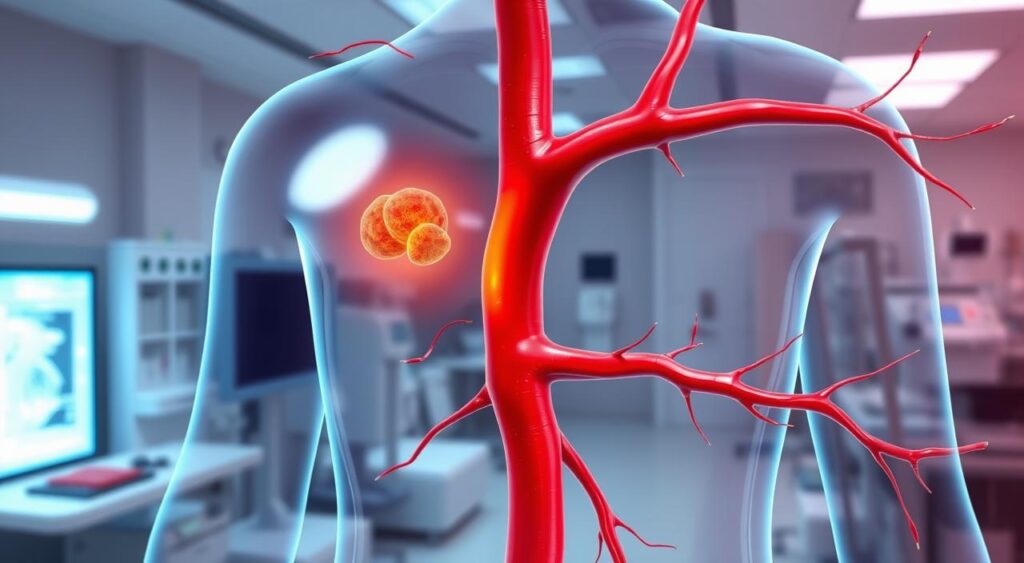Polyarteritis Nodosa: Learn about the causes, symptoms, and diagnostic process for this rare autoimmune disorder.
Polyarteritis nodosa is a rare disease that affects about 4.6 people per million. It’s an autoimmune disease that damages blood vessels. This can lead to many symptoms and complications.
It’s hard to diagnose and treat polyarteritis nodosa. Knowing about it is key to better treatment and outcomes. This disease can harm blood vessels and organs, affecting health greatly.

Looking into polyarteritis nodosa helps us understand it better. It’s a rare condition that needs careful management. This can prevent serious damage and improve life quality.
Key Takeaways
- Polyarteritis nodosa is a rare autoimmune disease that affects the blood vessels.
- The condition can cause a range of symptoms, including organ damage and other complications.
- Diagnosing polyarteritis nodosa can be challenging, but understanding the disease is essential for developing effective treatment plans.
- Treatment options for polyarteritis nodosa typically involve a combination of medications and lifestyle modifications.
- By managing the condition and preventing long-term damage, individuals with polyarteritis nodosa can improve their quality of life.
- As a type of pan, polyarteritis nodosa requires careful attention and management to prevent complications and improve patient outcomes.
Understanding Polyarteritis Nodosa: An Overview
Polyarteritis nodosa is a condition that affects blood vessels, causing inflammation and damage. It can lead to various symptoms, from mild to severe. This condition impacts different parts of the body.
The term vasculitis means inflammation of blood vessels, which can damage and narrow them. Polyarteritis nodosa specifically targets medium-sized blood vessels. This leads to inflammation and damage to the vessel walls. Such damage can cause serious complications, including organ failure.
What is Polyarteritis Nodosa?
Polyarteritis nodosa is a rare disease, affecting about 4-9 people per million each year. It is more common in men and can happen at any age. However, it usually affects people between 40 and 60 years old.
Historical Background
Polyarteritis nodosa was first described in the 19th century. Since then, our understanding of it has grown a lot. Now, we know it’s a complex disease linked to the immune system. It can be triggered by infections and genetic factors.
Types of PAN
There are several types of polyarteritis nodosa, including:
- Classic polyarteritis nodosa: This is the most common form, affecting medium-sized blood vessels.
- Microscopic polyarteritis nodosa: This form targets small blood vessels and often causes kidney damage.
- Cutaneous polyarteritis nodosa: This affects the skin, leading to symptoms like skin lesions and ulcers.
Knowing the different types of polyarteritis nodosa is key to effective treatment. Recognizing symptoms early and seeking medical help can reduce complications. This improves the quality of life for those affected.
The Impact of Polyarteritis Nodosa on Blood Vessels
Polyarteritis nodosa (pan) is a disease that affects the blood vessels. It causes inflammation and damage. This can make the blood vessels swell, leading to organ damage and poor circulation.
The effects of pan on blood vessels can be severe. It causes inflammation and damage to the vessel walls. Symptoms include high blood pressure, kidney damage, and poor circulation. In severe cases, it can cause the blood vessels to rupture, which is life-threatening.
Some of the key effects of pan on blood vessels include:
- Damage to the blood vessel walls, leading to inflammation and scarring
- Disruption of blood flow, leading to poor circulation and organ damage
- Increased risk of blood vessel rupture, leading to life-threatening complications
Understanding how pan affects blood vessels is key to finding effective treatments. By reducing inflammation and preventing damage, we can lower the risk of complications. This improves overall health outcomes.
Common Symptoms and Warning Signs
Polyarteritis Nodosa (PAN) is a condition that affects blood vessels. It leads to various symptoms and warning signs. Catching it early is key for proper treatment.
The symptoms of PAN can differ based on the organs affected. Common signs include fever, fatigue, and weight loss. These symptoms can be mild or severe and may appear quickly or slowly.
Knowing the symptoms of PAN is crucial for getting medical help fast. The condition can cause inflammation of the blood vessels, leading to organ damage. Some people may also experience skin lesions, joint pain, and muscle weakness. In severe cases, PAN can lead to organ failure, including kidney and liver failure.
Early Symptoms
- Fever
- Fatigue
- Weight loss
- Joint pain
- Muscle weakness
Advanced Manifestations
As PAN gets worse, symptoms can become more severe and widespread. Advanced symptoms may include high blood pressure, heart problems, and neurological symptoms. PAN can also cause gastrointestinal symptoms, such as abdominal pain and diarrhea.
Organ-Specific Symptoms
The symptoms of PAN can vary based on the organs affected. For example, kidney damage can lead to blood in the urine and high blood pressure. Liver damage can cause jaundice and abdominal pain. Understanding these symptoms is vital for early diagnosis and treatment.
| Symptom | Description |
|---|---|
| Fever | A high temperature, often above 100.4°F (38°C) |
| Fatigue | Feeling tired or weak, which can interfere with daily activities |
| Weight loss | Unintentional weight loss, which can be a sign of an underlying health problem |
Risk Factors and Triggers
Polyarteritis nodosa is an autoimmune disease. It can be triggered by genetics and the environment. Inflammation is key in its development. Knowing the risk factors helps prevent it.
Common risk factors include:
- Genetic predispositions
- Environmental factors, such as infections and exposure to toxins
- Autoimmune disorders, such as rheumatoid arthritis and lupus
People with a family history of autoimmune diseases are at higher risk. Some infections, like hepatitis B, can also trigger it.

Understanding polyarteritis nodosa’s risk factors is crucial. It helps in developing prevention and treatment plans. Recognizing causes lets people reduce their risk and manage symptoms.
| Risk Factor | Description |
|---|---|
| Genetic predispositions | Family history of autoimmune disease |
| Environmental factors | Infections, exposure to toxins |
| Autoimmune disorders | Rheumatoid arthritis, lupus |
Diagnostic Process and Testing Methods
Diagnosing Polyarteritis Nodosa involves a few steps. First, doctors do a physical exam and ask about your medical history. Blood tests are key, as they show if there’s inflammation or other issues.
These tests look at things like erythrocyte sedimentation rate (ESR) and C-reactive protein (CRP) levels. These are often high in people with Polyarteritis Nodosa.
To make a diagnosis, doctors look at your symptoms, lab results, and imaging studies. They use blood tests, imaging like angiography and ultrasound, and biopsies. Biopsies take tissue samples for closer examination.
Blood Tests and Laboratory Findings
Blood tests check for inflammation and other blood issues. They look at ESR and CRP levels, which are often high in Polyarteritis Nodosa patients. Other tests, like a complete blood count (CBC) and blood chemistry tests, check for other health problems.
Imaging Studies
Imaging studies like angiography and ultrasound show blood vessel problems. They help doctors diagnose Polyarteritis Nodosa and track how it’s progressing. These studies also spot complications like aneurysms or organ damage.
Biopsy Procedures
Biopsies, like skin or muscle biopsies, give tissue samples for more detailed checks. These samples confirm Polyarteritis Nodosa and find other health issues. Biopsies also help see how the disease is changing and if treatments are working.
Treatment Approaches and Management Strategies
For those with Polyarteritis Nodosa, an autoimmune disease, treatment is key. It helps manage symptoms and prevent more problems. The main goal is to lower inflammation and protect blood vessels.
Managing Polyarteritis Nodosa often means using medicine and making lifestyle changes. Doctors might prescribe corticosteroids to fight inflammation and immunosuppressants to calm the immune system. Sometimes, treatments like plasma exchange or surgery are needed too.
Important parts of treatment and management include:
- Medication to control inflammation and immune response
- Lifestyle changes, such as a healthy diet and regular exercise, to manage symptoms and improve overall health
- Regular monitoring and follow-up appointments with a healthcare provider to adjust treatment as needed
By teaming up with a healthcare provider and sticking to a detailed treatment plan, people with Polyarteritis Nodosa can manage their condition well. This helps them live a better life.

It’s important to remember that everyone’s experience with Polyarteritis Nodosa is different. Treatment plans can change based on how severe symptoms are and if there are other health issues.
| Treatment Approach | Description |
|---|---|
| Medication | Reduces inflammation and suppresses immune response |
| Lifestyle Changes | Includes a healthy diet, regular exercise, and stress management |
| Regular Monitoring | Follow-up appointments with a healthcare provider to adjust treatment as needed |
Medications and Therapeutic Options
There are many ways to treat Polyarteritis Nodosa. These treatments aim to reduce inflammation and protect blood vessels. They also help control the immune system.
Corticosteroids are often used to fight inflammation. Other treatments include immunosuppressants and biological therapies. These help prevent further damage to blood vessels.
Corticosteroids and Immunosuppressants
Corticosteroids, like prednisone, are key in treating Polyarteritis Nodosa. They reduce inflammation and calm the immune system. Immunosuppressants, such as cyclophosphamide, are also used to manage the condition.
Biological Therapies
Biological therapies, like rituximab, are another option. They target specific parts of the immune system to reduce inflammation.
Here are some treatments for Polyarteritis Nodosa:
- Corticosteroids: prednisone, methylprednisolone
- Immunosuppressants: cyclophosphamide, azathioprine
- Biological therapies: rituximab, infliximab
Choosing the right treatment for Polyarteritis Nodosa is crucial. With the right medications and therapies, managing the condition is possible. This can help prevent serious complications.
| Medication | Dosage | Side Effects |
|---|---|---|
| Prednisone | 10-60 mg per day | Weight gain, mood changes, insomnia |
| Cyclophosphamide | 50-200 mg per day | Nausea, vomiting, hair loss |
| Rituximab | 100-500 mg per infusion | Fever, chills, fatigue |
Living with Polyarteritis Nodosa: Lifestyle Modifications
Managing Polyarteritis Nodosa needs a full approach that includes lifestyle changes. Healthy habits in daily life help manage the condition and boost well-being. A balanced diet and regular exercise are key to staying healthy.
A good diet is vital for those with Polyarteritis Nodosa. It should include fruits, veggies, whole grains, and lean proteins. Consulting a healthcare professional or a registered dietitian can help create a meal plan. Regular exercise, like walking or swimming, also helps the heart and reduces inflammation.
Managing stress is also crucial. Activities like meditation or yoga can help deal with the emotional and physical challenges. By making these lifestyle changes, people can actively manage their condition and improve their life quality. Some important changes include:
- Eating a balanced diet
- Engaging in regular exercise
- Practicing stress-reducing techniques
By adopting these lifestyle changes, people with Polyarteritis Nodosa can lessen symptoms, improve health, and enhance well-being. It’s important to work with a healthcare team to create a personalized plan. This plan should include lifestyle changes, diet, and exercise to manage the condition well.
Prognosis and Long-term Outlook
Understanding the prognosis and long-term outlook of Polyarteritis Nodosa is key. The prognosis depends on how severe the disease is and how well treatment works. Early diagnosis and treatment can greatly improve the long-term outlook for those with Polyarteritis Nodosa.
Several factors can affect how the disease progresses. These include how many organs are involved, any underlying health conditions, and the person’s overall health. A good treatment plan, including medication and lifestyle changes, can help manage the disease. It’s important for those with Polyarteritis Nodosa to stay in close touch with their healthcare provider. This way, they can adjust their treatment plan as needed for the best prognosis and long-term outlook.
By understanding what affects the disease’s progression and working with their healthcare provider, individuals with Polyarteritis Nodosa can manage their condition better. With the right treatment and care, many people with Polyarteritis Nodosa see a big improvement in their symptoms and quality of life. This leads to a more positive prognosis and treatment outcomes.
Conclusion: Managing Polyarteritis Nodosa for Better Quality of Life
Polyarteritis nodosa is a complex condition that needs careful management for a better life. Early diagnosis and personalized treatment help patients manage their symptoms. They can also make lifestyle changes to improve their well-being.
Patients should work closely with their healthcare team to create a treatment plan. This plan might include medications, lifestyle modifications, and regular check-ups. These steps help control inflammation and protect vital organs. With the right support, people with polyarteritis nodosa can face challenges and find opportunities for a fulfilling life.
Even though polyarteritis nodosa is tough, there is hope. Patients can stay informed, advocate for themselves, and take a proactive approach to management. This way, they can control their health and aim for a better quality of life. Together, we can improve understanding and management of polyarteritis nodosa. This will empower those affected to live their best lives.
FAQ
Q: What is Polyarteritis Nodosa (PAN)?
A: Polyarteritis Nodosa (PAN) is a rare disease. It causes inflammation and damage to blood vessels all over the body. It’s a type of vasculitis, which means inflammation of blood vessels.
Q: What are the symptoms of Polyarteritis Nodosa?
A: Early symptoms include fever, fatigue, weight loss, and muscle and joint pain. As it gets worse, symptoms can include skin lesions, nerve damage, and organ problems. Specific symptoms can be high blood pressure, kidney issues, and stomach problems.
Q: How is Polyarteritis Nodosa diagnosed?
A: Doctors use blood tests, imaging studies, and sometimes a biopsy to diagnose PAN. Blood tests look for inflammation markers. Imaging tests like angiography or MRI show the damaged blood vessels. A biopsy confirms the diagnosis.
Q: What are the treatment options for Polyarteritis Nodosa?
A: Treatment for PAN includes corticosteroids and immunosuppressants to fight inflammation and an overactive immune system. Biologics like anti-TNF agents might also be used. Making lifestyle changes, like diet and stress management, helps too.
Q: What is the prognosis for individuals with Polyarteritis Nodosa?
A: The outlook for PAN depends on how severe it is and how well it responds to treatment. Many people with PAN can manage their symptoms and live well with treatment. But, if untreated, PAN can be deadly. It can also lead to serious complications like organ damage or heart problems.
